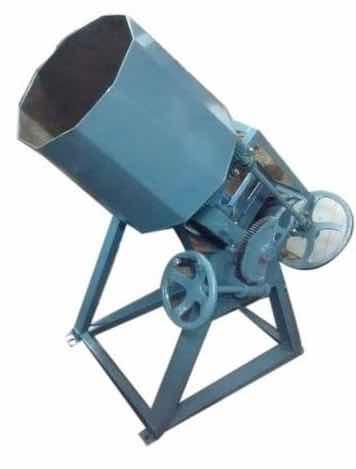Burnishing is perhaps the most popular mass-finishing application, but there are several benefits which make it a “go to” operation.
 Stephen Rudy CEFUnlike deburring, there is no metal removal involved in burnishing. In effect, burnishing helps to regulate the surface profile on parts. Focus is on honing and smoothening surface irregularities. The process cycle is selected by evaluating media, compound, equipment, and time.
Stephen Rudy CEFUnlike deburring, there is no metal removal involved in burnishing. In effect, burnishing helps to regulate the surface profile on parts. Focus is on honing and smoothening surface irregularities. The process cycle is selected by evaluating media, compound, equipment, and time.
Process attributes include:
- Applicability to all base metals including, stamped, drawn, and molded parts.
- Produces a bright, smooth, highly reflective surface.
- Removes surface organic soils and scales, facilitating surface preparation before a plating cycle.
- It can be non-aggressive, with very little metal removal from the surface.
- The focus is honing and removing surface imperfections.
- The base metal surface is leveled and polished before additional finishing.
- Improves brightness and leveling prior to plating. In some instances, the plating deposit thickness can be decreased.
Burnishing can be quantitatively expressed as a measure of the distance between high and low points on a metal surface (peaks to valleys). This can be instrumentally measured and interpreted as an RMS (root mean square). A higher RMS describes a rougher surface. The lower the RMS value, the flatter or more leveled the surface. For example, an RMS value of 1 describes a more highly burnished surface than one having an RMS of 5.
The critical success of burnishing is due to formation of a continuous lubricating film which prevents scratching or other physical attack on the metal surface. The operating mechanism involves the action of optional media on the film, transferring the energy to the parts during processing.
There are two classifications for burnishing:
- Burnishing: parts are processed with ceramic or porcelain media or without media (part on part). The expected finish is general brightening and leveling. The media-to-parts ratio is 6-10:1 in vibratory and 3-4:1 for horizontal barrel. Testing is required to determine the best ratio.
- Ball Burnishing: parts, usually softer metals such as aluminum and brass, are processed with case-hardened or stainless steel media, producing maximum brilliance. This can be accomplished before transfer to a plating cycle or after plating to improve the final luster of the finish.
Shine rolling is another mass-finishing process similar to burnishing. In shine rolling, parts are usually processed without media to deburr and enhance luster.
Burnishing compounds are available as powder and liquid concentrates. Effective burnishing compounds should contribute these operating benefits:
- Provide a thin lubricating film, as lubricity is very important.
- Water hardness tolerance
- pH buffered for the application
- Rust and corrosion inhibition
- Flexible foaming characteristics (high and low)
Active components of the burnishing compound work on the part surface, leaving a residual film. Upon burnishing compound working solution make up, it should be at point of just being soluble. The all important film is then apparent, to work on the metal surface. This is usually seen by the water break condition after post-burnishing rinsing.
If the parts processing cycle is complete at this point, the parts are dried leaving the protective, clear film on the parts. Standard soak cleaning should remove this film as part of a surface preparation cycle before plating. Application features for burnishing systems vary somewhat between liquid and powder concentrates:
Application: Liquid Type
- Significant handling and control benefits in flow through vibratory systems.
- Easily used in horizontal and oblique barrels.
- It can be metered as pre-diluted or in ratio with water.
- The working solution concentration may range from 0.5% to 2.0 vol%.
- In vibratory equipment, the solution works through the load and drains out at a continuous flow rate of 1 to 5 gal/ft3/ hr.
- The solution pH may range from 3 to 11 per the specific parts and surface finish requirement.
A liquid system offers several benefits. Direct handling of the concentrate is minimal, benefiting worker safety. In some applications, a sufficient amount of product may be consumed, permitting the use of returnable containers, such as totes, thereby eliminating packaging disposal requirements. As a prediluted working solution, the concentrate is metered at a fixed rate, continually delivering a fresh, active working solution to condition the parts. Equipment requirements are rather simple.
The drum or tote of concentrated stock solution is connected to a calibrated pump, set to deliver the prepared solution at the preferred flow rate, diluted with the required volume of water. Depending on desired quality and effectiveness, the “one pass” solution may be recycled until determined to be spent. Other than the enclosed horizontal barrel, parts can be easily sampled to examine the cycle's progress. In horizontal barrels, the concentrate is added along with water and the optional media.
Final preparation is made before the barrel burnishing cycle begins. All the benefits and simplified operations are contingent upon proper cycle development. This is true for any mass-finishing cycle.
Application: Powder Type
- It is preferred to be added to horizontal and oblique barrels. Its use in vibratory equipment is compatible, especially for shorter cycles.
- Addition rates of 1 to 4 oz/gal of burnishing compound per gallon of required water.
- A working solution containing parts and optional media tumbles for a desired time.
- The working solution's pH range may be mildly acidic, pH 4-6), an alkaline pH range of 7 to 11.
The powdered burnishing compound is added for each cycle run, ensuring a fresh, optimized chemical mix to condition the parts. Powdered systems offer benefits in that particular active components may be formulated into the blend, exceeding the amount that can be dissolved into a liquid product. Soaps, certain conditioners, and surfactants are some components affected in this way. Powdered burnishing compounds are equivalent in effectiveness to their liquid counterparts.
Trouble Shooting Tips
| Problem | Possible Cause | Correction |
| Dull hazy finish | Oil and grease in film | Preclean before burnish |
| Dull (no oily soils) | Scale | Descale first |
| Parts stained rusty tarnished | Insufficiently dried parts | Dry quickly after rinse |
| Media and parts float | Excess compound water | Adjust concentrations |
| Parts cushioned | Excess compound | Adjust concentration |
| Rust corrosion | Very low compound conc. | Adjust concentration |
| Scratchy dull | Very low compound conc. | Adjust concentration |
| Media parts corrode | Very low compound conc. | Adjust concentration |
Additional Facts
- Burnishing cycles typically range from 20 to 60 minutes. Longer cycles may be required based on specific testing and evaluation.
- Rust inhibitors protect steel parts. In particular, they protect steel media for long, dependable service life.
- Inhibitors prevent tarnishing and darkening of brass and copper alloys, as well as corrosion of zinc and aluminum.
- Acidic burnishing removes smut and carbon deposits off steel after descaling and deburring before the final burnishing treatment.
- Descale, de-tarnish, and burnish copper, brass, and bronze in one step.
Media
Six shapes of case-hardened steel media are normally used: ball, ball cone, diagonal, oval, pin, and wheat. The ball is best used unless specific geometric shapes result in lodging or insufficient media-to-part surface contact. Keeping steel media clean and protected with a rust inhibitor will prevent pitting and rusting.
Ceramic and porcelain types are available in surface finishes that permit their use in deburring, descaling, and burnishing without changing the media. These types may exhibit a smooth, glazed surface containing a fixed amount of selected abrasives. Different shapes preferentially work on condition-specific geometrically formed parts.
Keeping the media clean is key to effective burnishing. New media must be preconditioned to eliminate sharp edges and corners. Generally, media-to-parts ratios of 10:1 to 20:1 are used in burnishing cycles.
The optimum media-to-parts ratio is factored into the burnishing process's chemistry and concentration by the equipment's mechanical action.
Specific Media Shapes for Effective Burnishing Applications
- Triangles and Tetrahedrons: effective to work slotted areas and reach into corners.
- Cones: concave and convex surfaces.
- Pyramids and Wedges: provide large, flat surface for contact. Tops penetrate holes, but don’t pass through.
- Angle Cut Cylinders and Stars: work inside diameters and blind holes. Reduce lodging problems.
Equipment
 Vibratory Polishing Machine from Inovatec.Horizontal and oblique barrels are charged with media, burnishing compound, and sufficient water. Loading the barrel to 50% to 60% of total capacity is sufficient for many process cycles. This loading and barrel speed are critical to obtaining the best slide zone. This is where parts, media, and active chemicals slide together, facilitating the optimum action of media and chemicals on the parts. Since this only occurs on the downward slide in the barrel, testing is required to determine proper loading. Barrel speed must also be set to prevent centrifugal forces (usually at a rotation speed too high) that would prevent the parts from sliding.
Vibratory Polishing Machine from Inovatec.Horizontal and oblique barrels are charged with media, burnishing compound, and sufficient water. Loading the barrel to 50% to 60% of total capacity is sufficient for many process cycles. This loading and barrel speed are critical to obtaining the best slide zone. This is where parts, media, and active chemicals slide together, facilitating the optimum action of media and chemicals on the parts. Since this only occurs on the downward slide in the barrel, testing is required to determine proper loading. Barrel speed must also be set to prevent centrifugal forces (usually at a rotation speed too high) that would prevent the parts from sliding.
Safety advice for operating closed barrels. Pressure buildup occurs. Automatic vents should be fitted on barrels. Vent before the cycle is complete. This prevents the lid from blowing off under pressure. Do not open a hot barrel. Wear protective gear and face shield.
 Oblique Open End Burnishing Unit from Komal Corp.Vibratory equipment uses vibrational and rotational energies to work with media and burnishing chemicals. Mechanical work is constantly performed on parts, which results in faster action. Trial evaluations should be conducted to optimize the energy setting of equipment in relation to chemistry type, concentration, and media-to-parts ratio.
Oblique Open End Burnishing Unit from Komal Corp.Vibratory equipment uses vibrational and rotational energies to work with media and burnishing chemicals. Mechanical work is constantly performed on parts, which results in faster action. Trial evaluations should be conducted to optimize the energy setting of equipment in relation to chemistry type, concentration, and media-to-parts ratio.
Typical Vibratory Cycle:
- Adjust flow rate of meter and compound.
- First run in order to wet media, bowl, and start the drain.
- Add parts and run for specified time.
- Rinse briefly or unload parts through a screen separator.
- End or transfer to next process.
For example, a 5 ft3 vibratory unit requires 15-25 gal/hr of liquid flow, consisting of approximately 0.1 gallon (13 fl oz) of burnishing compound.
Stephen F. Rudy, CEF, is president of Chem Analytic and has written extensively about the finishing industry. Visit www.chemanalytic.com or call him at 917-604-5001.
























